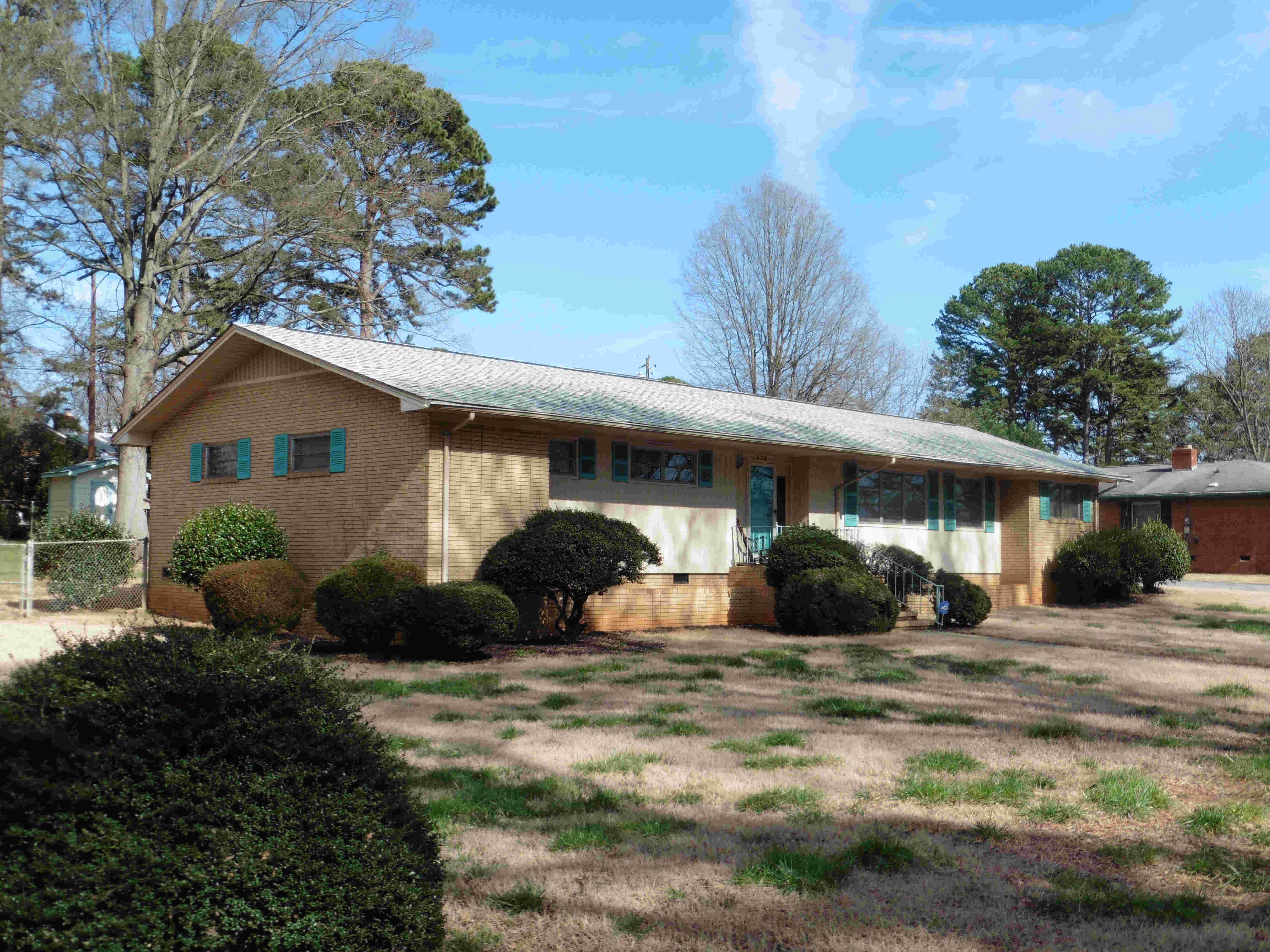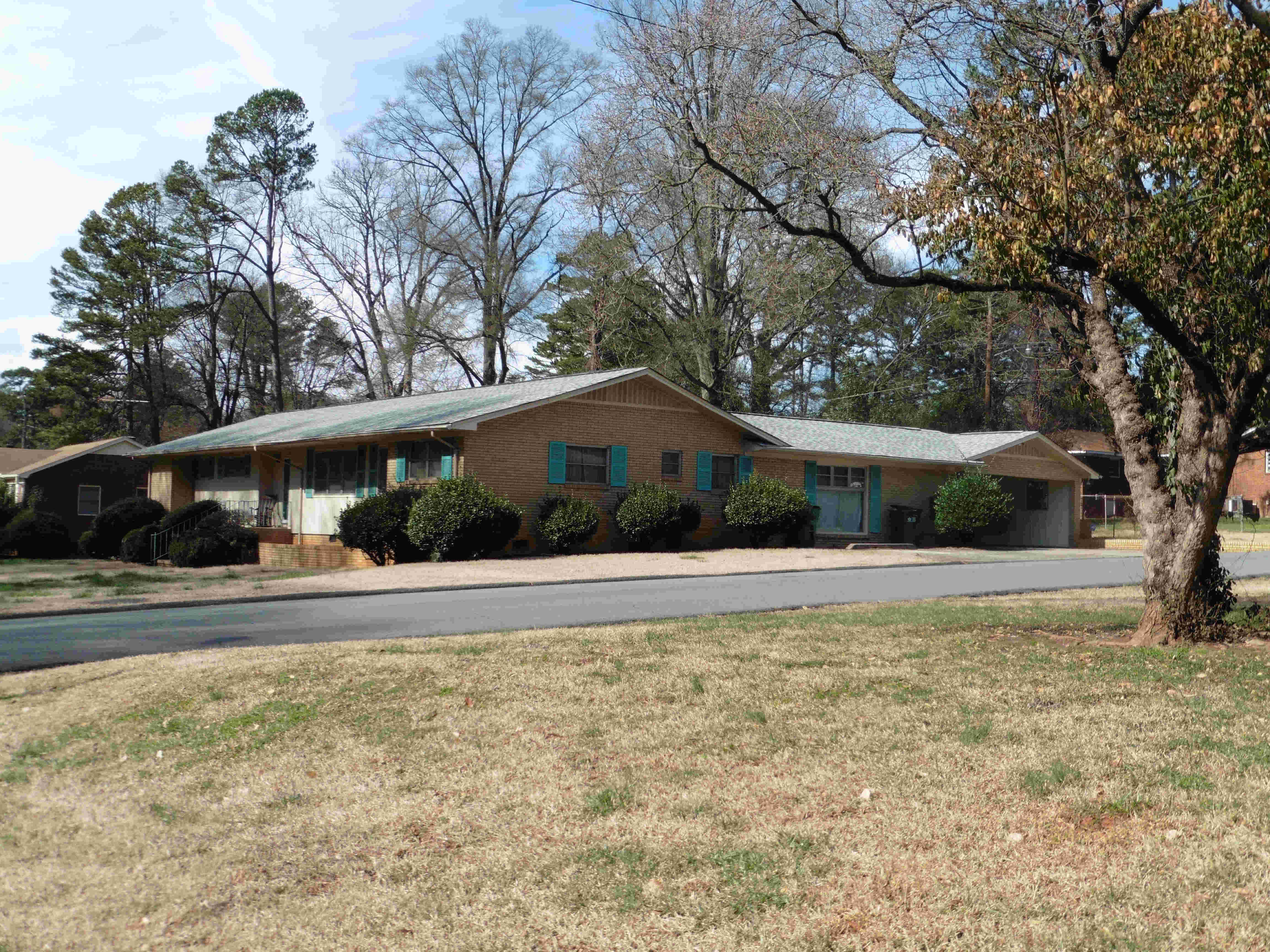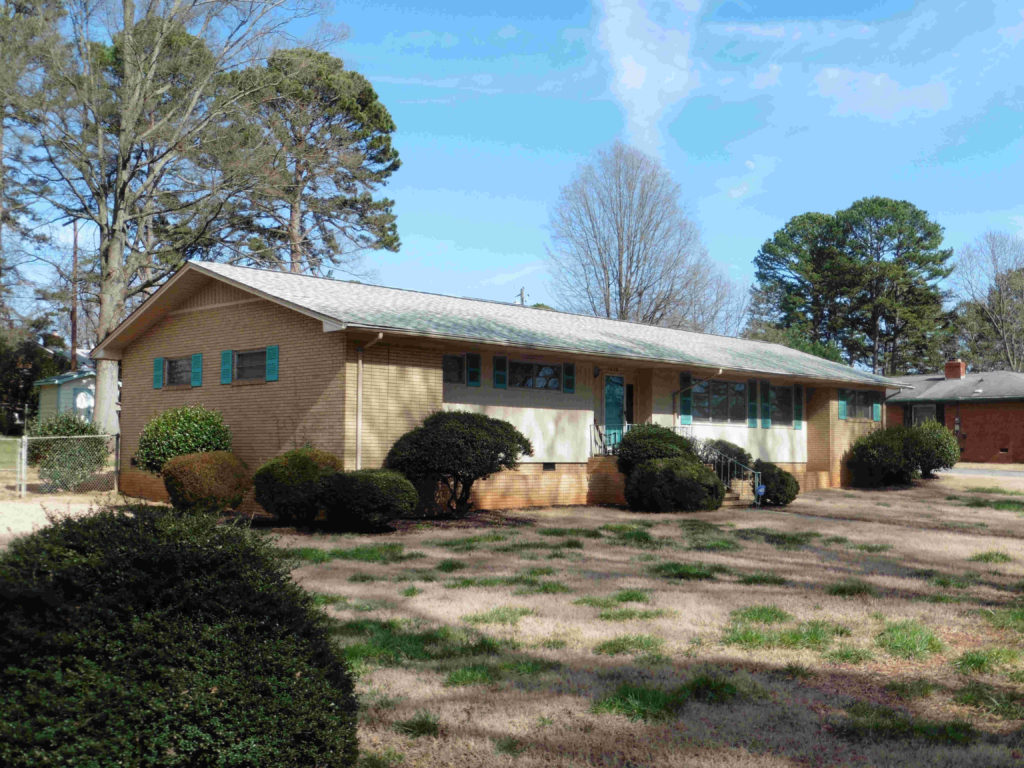1624 Madison Avenue
Built during 1962 – 63 for physician Dr. Drayton P. Graham and his wife Carolyn, a counselor at Johnson C. Smith University. The Graham family took an active role in Civil Rights efforts, working for school desegregation and for equal healthcare. Later this residence became the longtime home of Dr. Esther Page Hill, one of the pioneering African American professors at UNC Charlotte, and her husband Samuel Hill, a music educator.
* * *
Dr. Drayton Graham arrived in Charlotte in 1956 to set up practice in obstetrics and gynecology.[1] He had been born in 1920 in McClellanville on the South Carolina coast near Charleston, attended school at Snow Hill Institute in Alabama, Hampton Institute in Virginia, and Virginia State College, then earned his medical degree from prestigious Meharry Medical College in Nashville.[2] He first rented space in the Watkins Building, a favorite office address for professionals in Charlotte’s African American neighborhood of Brooklyn. In 1959 he bought and extensively renovated a house at 1230 Beatties Ford (now the Masjid Ali Shah Mosque) to create an office/clinic building close to suburban McCrorey Heights.[3]
The Graham family quickly became involved in Civil Rights work in their new hometown. In 1954 the U.S. Supreme Court had ruled in the national landmark case Brown v Board of Education that separate Black and white schools were unconstitutional and must desegregate. But Charlotte did nothing. So the local chapter of the NAACP came up with a plan of action. In the summer of 1957, the Grahams became one of 35 families who applied individually to have their children attend desegregated schools.[4] That might seem like a simple act today, but it took courage; your name and your address were published in the newspaper, opening you to reprisals. And when the School Board turned down the application with little explanation, the most persistent families, including the Grahams, went back to the Board of Education to file appeals.
Ultimately the Superintendent did agree to admit just five youngsters to white schools in the Fall of 1957. Drayton Graham, Jr., and his sister Beryl were not on that list – but fellow petitioners Dorothy Counts, Delois Huntley, Gus Roberts and Givaud Roberts were.[5] Today Counts and the others are celebrated as Civil Rights history-makers. Few remember the quiet, firm, courageous pressure by all the applicants that formed the essential background to that visible success.
Another major goal of Charlotte Civil Rights activists was to end the separate, unequal healthcare situation. Since the 1880s, Black Charlotteans had been limited to using Good Samaritan, a Black hospital whose facilities were sharply inferior to whites-only Charlotte Memorial Hospital (now Atrium Health), Presbyterian Hospital and Mercy Hospital. That began to change in 1962 and 1963 as Memorial reluctantly allowed African American doctors to use its facilities. But the institutions continued to drag their feet. Dr. Graham and a colleague protested the situation in a 1965 series of newspaper articles. Among the complaints: the waiting list to get Black patients into the hospital ran five to seven days, they charged, while similar white patients were admitted in two days.
Ultimately, Graham gave up in frustration and moved his medical practice and his family to Atlanta in 1965. “Things are really integrated down here,” he told the Observer. “In Charlotte there’s a lot of talking, but no action.” [6]
* * *
The Graham children, who had been part of history-in-the-making during their formative years in Charlotte, continued to make history as they grew up. Beryl became an author and a scholar of African American history and children’s literature. She was affiliated with Atlanta’s Morris Brown College, then became a professor of history at Georgia Perimeter College in Atlanta. [7]
Her brother Drayton P. Graham, Jr., who spent his capstone high school years in this house at 1624 Madison Avenue, followed his father’s footsteps into the medical profession. As he prepared to graduate from West Charlotte High, Charlotte Observer named him to its annual list of all-star high school scholars in 1965, alongside fellow McCrorey Heights teens Janice Belton and Howard Counts.[8] Young Graham went off to college at Columbia University in New York City. He co-wrote a 1967 opinion piece in Columbia’s college’s newspaper describing the difficulties faced by black students in white institutions that were just then beginning to open their doors to African Americans.[9] Notice of his wedding in the social column of the Pittsburgh Courier in 1970 mentioned that he was enrolled at Harvard Medical School.[10] Drayton P. Graham, Jr., went on to practice medicine in the Los Angeles area, becoming director of respiratory services at a hospital in Marina Del Ray.[11]
* * *
Esther Page Hill, the next occupant of 1624 Madison Avenue along with her husband Samuel Hill, had been born the daughter of a minister in the eastern North Carolina railroad town of Rocky Mount.[12]The family soon moved to Brooklyn, New York, part of the Great Migration of southern African Americans to the big-city north. Her parents sent her to private schools in Brooklyn and Bridgeport, Connecticut; she graduated from high school at Greater New York Academy. She did college work back down south at North Carolina Central in Durham, then finished at Columbia University Teacher’s College in New York City with a BA in Social Studies Education. Soon after she met and married Samuel Hill.
She loved teaching, taking positions at public schools in Virginia and New York, but her deepest passion was for art. After half a dozen years in the classroom she won admission to the Columbia University Teachers College program in art education. She gained a Masters in Fine Art and Arts Education with emphasis on textile design.
With degree in hand she came to Charlotte to take a position as Art Supervisor for Charlotte Mecklenburg Schools. UNC Charlotte, moving into its new suburban campus on Highway 49 in mid 1960s, lured her from CMS. The white colleges in the University of North Carolina system were finally beginning to integrate their professorial ranks. Mrs. Hill began as an Associate Professor of Visual Arts and a member of the graduate faculty. In addition to teaching, she continued to produce art herself; pieces are in collections including that of U.S. Congressman Mel Watt.[13] She won a professional development fellowship from the University’s Board of Governors which allowed her to begin doctoral work at Florida State University.[14] She earned a Ph.D. in Art Education in 1986, becoming Dr. Esther Hill — one of the very few black female Ph.Ds in her generation.[15]
Esther Hill and husband Samuel moved into their sprawling house on Madison Avenue in the late 1960s and lived there for the rest of their lives, filling it with art and music and raising daughter Samesta. Samuel Washington Hill (7.19.1909 – 4.19.1998) grew up in Anniston, Alabama, where at age fifteen he served as organist and choir director at his grandfather’s church.[16] He earned his undergraduate degree in music at Alabama’s Talledega College specializing in piano and organ. He went on to attain a Masters in Music and Music Education at Columbia Teachers College in New York City — perhaps where he met Esther.
Samuel Hill’s career as a music teacher and choir director began at Palmer Institute, the elite African American boarding school near Greensboro, N.C. He taught in Alabama, Virginia, New York and Charlotte, but his best known engagement was as Assistant Professor of Music at North Carolina College in Durham, N.C., now North Carolina Central University. Said his funeral program: “Mr. Hill’s choirs performed 249 eminently successful concerts in cities throughout the eastern United States.
“Through music, the lives of thousands of people have been touched by Mr. Hill. While serving in the U.S. Army as the Chaplain’s Assistant for two years, he performed personal piano concerts and directed the Male Choir at Camp Lee, Virginia. He served as the Minister of Music at Concord Baptist Church in Brooklyn [N.Y.], which boasted 5000 members and three choirs. Before retiring from sharing his musical talents with the community, Mr. Hill was minister of Music for several local churches in Charlotte; Director of Phi Pi Chapter Ensemble, Omega Fraternity, Charlotte; and director of the Charlotte Alumnae Chapter Ensemble, Delta Sigma Theta.”[17]
[1] “Dr. Drayton P. Graham,” Charlotte Observer, July 16, 1956. https://www.newspapers.com/image/618923856
[2] “Drayton P. Graham, Sr., Retired Physician,” Atlanta Constitution, October 29, 1992. https://www.newspapers.com/image/402798587/ “Dr. Drayton P. Graham,” Charlotte Observer, October 30, 1992. https://www.newspapers.com/image/626500034/
[3] “Office Building to be Dedicated,” Charlotte News, October 3, 1969. https://www.newspapers.com/image/619813517/
[4] “More Applications Received for Negro Pupils’ Transfer,” Charlotte News, June 7, 1957. https://www.newspapers.com/image/618143677/ Included Dorothy Counts. “School Board Denies 20 Negroes’ Appeals,” August 15, 1957. https://www.newspapers.com/image/618140876/
Superintendent Garinger accepted five transfers, turned down the rest. “City School Board Appeals Up to 23,” Charlotte News, July 31, 1957. https://www.newspapers.com/image/618144318/ and https://www.newspapers.com/image/618144221
[5] Frye Gaillard, The Dream Long Deferred: The Landmark Struggle for Desegregation in Charlotte, North Carolina, third edition (Columbia, South Carolina: University of South Carolina Press, 2006).
[6] “Two Negro Doctors Assail Hospitals: Five Others May Leave City, Too,” Charlotte Observer, April 12, 1965. https://www.newspapers.com/image/620315916/ “Hospital Answers Dissidents,” Charlotte Observer, April 13, 1965. https://www.newspapers.com/image/620315977/
[7] “A Children’s Primer on Martin L. King, Jr.,” Atlanta Constitution, January 15, 1984. https://www.newspapers.com/image/399136167/ “School Briefs,” Atlanta Voice, October 13, 1990.
[8] “Wait, Who was an All-Star Scholar?” Charlotte Observer, June 9, 2014. On-line at: http://obsyoungachievers.blogspot.com/2014/06/
[9] “A ‘Special’ Student,” Columbia Daily Spectator, April 26, 1967. On-line at http://spectatorarchive.library.columbia.edu/cgi-bin/columbia?a=d&d=cs19670426-02.2.7&e=——-en-20–38312–txt-IN-columbia—-#
[10] “Toki Types” (Graham Jr. wedding), Pittsburgh Courier, September 26, 1970. On-line at: www.newspapers.com/image/39194037/
[11] “Flu and the Common Cold,” Los Angeles Times, December 5, 1982. On-line at: https://www.newspapers.com/image/390456556/
[12] A Celebration of the Life of Dr. Esther Page Hill,” undated circa February 4, 2014, funeral program on-line at http://mccrorey.historysouth.org/wp-content/uploads/2014/06/Hill_Dr_Esther_Page.pdf “Doctoral Work Becomes Reality for Rocky Mount Native,” Rocky Mount Telegram, July 27, 1986. https://www.newspapers.com/image/337716294/ “Esther Hill,” obituary published by the Charlotte Observer, February 4, 2014. https://www.legacy.com/us/obituaries/charlotte/name/esther-hill-obituary?id=12320967
[13] “A Very Personal Collection,” Charlotte Observer, December 30, 2010. On-line at: http://www.charlotteobserver.com/entertainment/article9048758.html
[14] A Celebration of the Life of Dr Esther Page Hill,” undated circa February 4, 2014, funeral program on-line at http://mccrorey.historysouth.org/wp-content/uploads/2014/06/Hill_Dr_Esther_Page.pdf
[15] “Doctoral Work Becomes Reality for Rocky Mount Native,” Rocky Mount Telegram, July 27, 1986. https://www.newspapers.com/image/337716294/
[16] “Mr. Samuel (Sam) Washington Hill,” obituary in Charlotte Observer, April 21, 1998. “In Triumphant Celebration and Loving Memories of Mr. Samuel W. Hill, April 22, 1998,” funeral program on-line at: http://mccrorey.historysouth.org/wp-content/uploads/2014/06/Hill_Samuel.pdf
[17] “In Triumphant Celebration and Loving Memories of Mr. Samuel W. Hill, April 22, 1998,” funeral program on-line at: http://mccrorey.historysouth.org/wp-content/uploads/2014/06/Hill_Samuel.pdf


Architecture
One of the largest and most stylish Ranch houses in McCrorey Heights, built with unusual yellow-white brick on an oversized corner lot. The layout forms an “L” with the main block of the house facing the street, then a rear wing extending along Creek Street and terminating a garage. There is likely a rear courtyard sheltered from the street in the crook of the “L.” The gable roofs have deeper eaves than is usual in McCrorey Heights, adding to the horizontality of the design. The front facade has an unusual horizontal stucco panel, bordered by brick laid in stack bond; no other house in Charlotte has a similar architectural feature. Windows are all wider than they are tall, including a strip widow adjacent to the front door. All in all, the design resembles the early Ranch houses built in suburban California in the late 1940s and early 1950s and publicized via Sunset Magazine, rather than the simpler examples typical somewhat later in the Southeastern U.S.
Building permit
Madison 1624 permit
Date issued: November 9, 1962
Owner: Dr. D. P. Graham
Contractor: H. W. Carriker
Estimated cost: $19,500
Other permit info: Build residence
First appeared in city directory
1964 – Drayton P. Graham & Carolyn or Caroline W.
He: Physician at 1230 Beatties Ford Rd.
She: Counsellor, JCSU.
1981 city directory — Esther P. Hill, retired
obituary
Resources
Lane, Barbara Miller, Houses for a New World: Builders and Buyers in American Suburbs, 1945 – 1965 (Princeton University Press, 2015).
“Flu and the Common Cold,” Los Angeles Times, December 5, 1982. On-line at: www.newspapers.com/image/169957345/?terms=”Drayton%2BP.%2BGraham”
The Links, photograph in Vermelle Diamond Ely, Grace Hoey Drain and Amy T. Rogers, Charlotte, North Carolina, in the Black America Series (Arcadia Press, 2001), p. 101.
“A ‘Special’ Student,” Columbia Daily Spectator, April 26, 1967. On-line at http://spectatorarchive.library.columbia.edu/cgi-bin/columbia?a=d&d=cs19670426-02.2.7&e=——-en-20–38312–txt-IN-columbia—-#
“Toki Types” (Graham Jr. wedding), Pittsburgh Courier, September 26, 1970. On-line at: www.newspapers.com/image/39194037/?terms=”Drayton%2BP.%2BGraham”
“A Very Personal Collection,” Charlotte Observer, December 30, 2010. On-line at: http://www.charlotteobserver.com/entertainment/article9048758.html
“Wait, Who was an All-Star Scholar?” Charlotte Observer, June 9, 2014. On-line at: http://obsyoungachievers.blogspot.com/2014/06/
